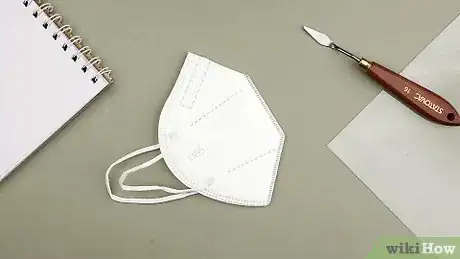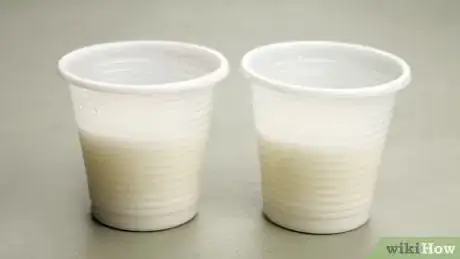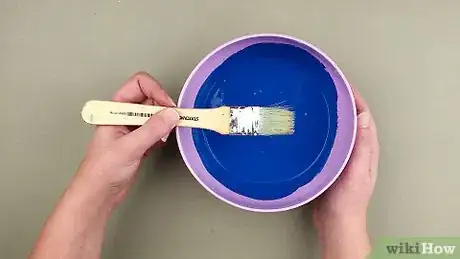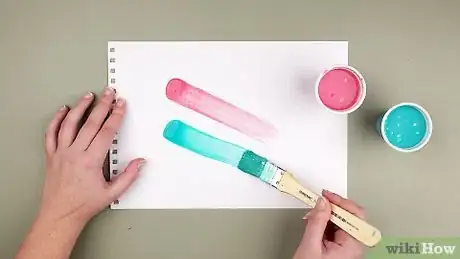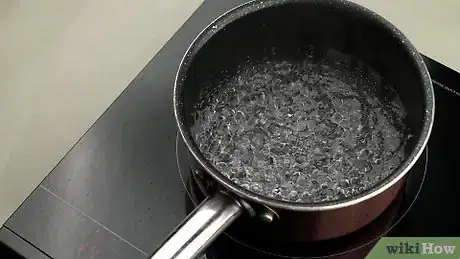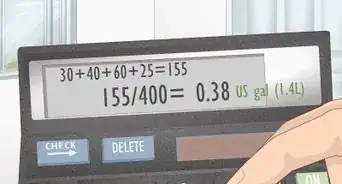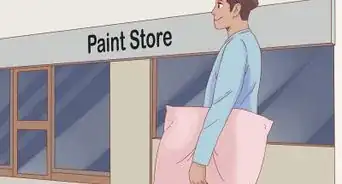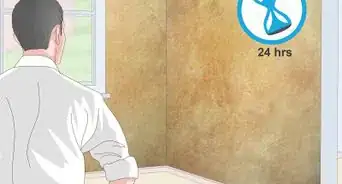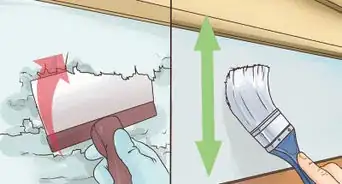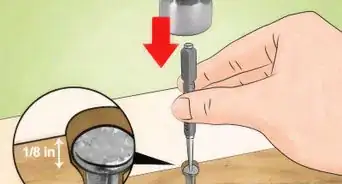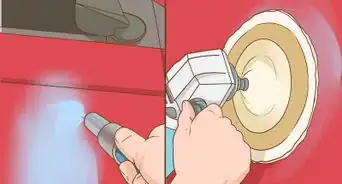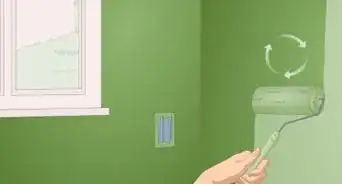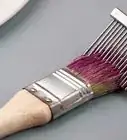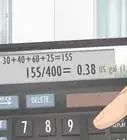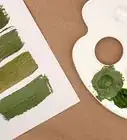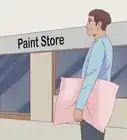This article was co-authored by Jeanine Hattas Wilson. Jeanine Hattas Wilson is a Professional Painter and the President of Hattas Public Murals, Inc. With nearly 20 years of experience, Jeanine specializes in creating, overseeing, designing, and painting murals. Jeanine holds a BA in Advertising from Marquette University and a Studio Painting Minor from The Milwaukee Institute of Art & Design. She has studied at The Atelier Artien in Paris, France, Los Angeles Academy of Figurative Art, and under renowned artists such as Robert Liberace, Michael Siegel, and William Cochran. To date, Hattas Public Murals has painted nearly 5,000 commissioned works of art in homes and commercial and public spaces.
There are 12 references cited in this article, which can be found at the bottom of the page.
This article has been viewed 274,972 times.
Instead of shopping for manufactured paint, make your own out of a few inexpensive ingredients! Paint that is safe for children of all ages can be made quickly with flour or corn syrup. More experienced artists can mix their own acrylic paint using raw pigment and a medium. We'll show you how to DIY your own flour-based, watercolor, and acrylic paint for a satisfying, yet entertaining project that also saves you money.
Steps
Making Acrylic or Oil Paint
-
1Wear a dust mask to protect yourself from the paint. Since you will be working with paint pigments and a medium, protect yourself by wearing a mask or respirator. You may also want to cover your arms by wearing long-sleeved clothing.[1]
- The paints are non-toxic unless you use metal-based pigments like “cadmium red.” However, these paints are not meant for use on skin.
-
2Pour raw color pigment onto a flat mixing surface. You will need dry paint pigment in the color you wish to make. Pour about 1 tablespoon, or 1⁄2 ounce (14 g), of pigment onto a mixing surface such as a paint palette or slab.[2]
- You can find dry paint pigment at art supply stores. Each pigment has a visible color and is labeled appropriately, such as Titanium White or Red Iron.
- Many artists use glass or stone slabs. You may be able to find plexiglass at a home improvement store and use that to mix your paint.
Advertisement -
3Pour 2 drops of water if you want to smooth out the pigment. Adding a little bit of water can help you get the paint to the proper consistency. Spread the paint to create space in the center of the pigment pile. Using a pipette or eye dropper, squeeze 2 or 3 drops of water into the space.[3]
- If the pigment isn’t completely smooth, the paint may look grainy once you use it later.
-
4Mix the paint and water with a palette knife. Use a palette knife or spatula to spread the water throughout the pigment. Mix the paint until it has a smooth, sauce-like consistency. Try to eliminate any clumps of raw pigment you see.[4]
- You might not be able to remove all the lumps right away. This is okay, since you will get another chance to thin the paint.
- If you make your own paint often, consider purchasing a paint muller online or from an art supply store. A paint muller grinds and disperses raw pigment.
-
5Add your paint medium to the pigment. Start with approximately 2 tablespoons, or 1 fl. oz., of your liquid paint medium. The medium you choose depends on what type of paint you want to make. Art supply stores sell different mediums for acrylics, or you can get a plant-based oil to make oil paint.[5]
- For example, you can use a gloss medium to make thin, transparent acrylic paint.
- You could add a gel medium to acrylic paint for an impasto-style painting.[6]
- For oil paint, use linseed, walnut, or poppy oil.
-
6Mix the paint and add more of the medium for consistency. Use your palette knife or spatula to combine the pigment and medium. When the paint is at the proper consistency, it will appear smooth, firm, and a little glossy. Adjust the paint by adding more of the medium as necessary until it reaches the consistency you desire.[7]
- Add the medium gradually while mixing it into the paint. Check the consistency frequently so you don't add too much.
- Excess paint may be spread onto tin foil, wrapped up tightly, and preserved in a freezer for at least 2 or 3 months.
Making Watercolor Paint
-
1Boil sugar and water in a stovetop pot. Add about 8 fluid ounces (240 ml) to a pot safe to heat on the stove. Stir in 16 ounces (450 g) of white sugar. Turn the heat on the stove to high until the water boils.[8]
- Instead of doing this, you can purchase light corn syrup from a grocery store. You don’t need to boil anything. Simply mix the syrup in with the other ingredients.
- This creates a non-toxic paint safe for children. It’s easier to spread and more similar to store-bought watercolors than flour paint.
-
2Turn the heat down and stir the mixture into a syrup. Turn the heat down to low after the water begins to boil. Stir the sugar mixture continuously for about 3 to 5 minutes until the sugar dissolves. Once the mixture becomes a clear syrup, remove the pot from the heat.[9]
- Scoop up the mixture with a spoon to check for undissolved sugar crystals.
- The longer you boil the mixture, the thicker it becomes after it cools. If you boil it too long, it may burn.
-
3Mix baking soda, cornstarch, white vinegar, and corn syrup. Pour about 1 ½ tablespoons, or .75 fluid ounces (22 ml) of corn syrup from the pot into a mixing bowl. Add 1.5 fluid ounces (44 ml) of white vinegar. Also add 1.5 ounces (43 g) each of baking soda and cornstarch. Mix the ingredients into a smooth liquid.[10]
- You can find all of these ingredients at most grocery stores.
-
4Pour the paint into small containers. Separate the paint into small bowls, such as tea-light holders. Use a different container for each color of paint you wish to make.[11]
-
5Add 2 drops of food coloring to the paint. Pick out a few different dyes to give your art plenty of color. Start with only a few drops of food coloring so the paint doesn't turn too dark. You can add more drops after mixing the paint.[12]
- If you can’t find a specific color, mix different colors to create it. For instance, mixing 2 drops of yellow and 1 drop of red can create orange.
-
6Mix in the food coloring using a toothpick. Stir the paint around in the container until the food coloring is dispersed throughout it. Use a different toothpick for each container in order to avoid crossing the colors. Then, you can brush the paint onto paper. The best surface to use is watercolor paper, since it holds up better to liquid paint than regular paper..[13]
- Wash off your paint brush after using it to crossing colors.
- This paint is like store-bought watercolors, so you can mix colors on paper. The paint also dries slowly, drying faster under heat.
- The paint can be stored in a covered container in a refrigerator. It will usually last a couple of weeks. Throw it away if you notice mold growing on it.
Creating Chalk Paint for Furniture
-
1Mix water and baking soda together in a bowl. Pour 1.5 fluid ounces (44 ml) of cool water into a mixing bowl. Make sure you use tap water below room temperature. Next, add about 4 ounces (110 g) of baking soda.[14]
- This paint is an inexpensive way to give furniture an aged, distressed look.
- The paint is non-toxic, but swallowing it can make you feel temporarily sick.
- The paint can also be made with Plaster of Paris or unsanded grout instead of baking soda. Use 4 ounces (110 g) of either substance.[15]
-
2Stir the mixture until it looks smooth. Swirl the mixture in the bowl with a mixing spoon or another utensil. Continue mixing until all of the baking soda disperses. The liquid should look completely smooth.
-
3Pour the mixture into a cup of latex paint. Pour about 8 fluid ounces (240 ml) of a latex paint into a paint bowl. The paint can be any color you want. Then, add the baking soda and water mixture into the paint, stirring it with a paint mixing stick.[16]
- You can get latex paint at a home improvement store. Make sure it is latex-based. Oil paints are different and dry slower.
-
4Spread the paint onto furniture with a paint brush. The chalk paint will come out smooth like any regular latex paint. It needs to be applied right away to any furniture you wish to color. Coat the furniture with the paint to give it a chalky, distressed appearance.[17]
- The paint will begin drying within a few hours. Wait about a day to ensure it dries completely.
- After the paint dries, you can sand it even with 180 to 220-grit sandpaper.
- To dispose of excess paint, leave it out in the open. Since it is made with latex paint, it will dry. Then you can throw it in the trash.
Making Flour-Based Paint
-
1Pour white flour, water, and salt in a bowl. Pour 1 cup, or 8 fluid ounces (240 ml), of warm water into a large mixing bowl. Also add 12 ounces (340 g) each of white flour and table salt. Mix the ingredients into a smooth liquid.[18]
- This creates a quick-drying, non-toxic paint safe for children of any age.
- Adjust the amount of each ingredient you use to create more or less paint. Keep the ingredients in the same ratio.
-
2Divide the paint into separate containers. Distribute the paint evenly among a few small bowls or squeeze bottles. Resealable plastic bags also work well with this kind of paint.[19]
- With a zippered plastic bag, you can cut a corner later to let out a steady drip of paint. This eliminates overturned paint containers and reduces messes.
-
3Pour 2 drops of food coloring into the paint. Choose a paint color, then squeeze 2 or 3 drops of food coloring into the paint. Give yourself a color palette by mixing a different color into each container. You can add more drops as needed if the paint’s color isn’t dark enough.[20]
- If you can’t find a specific food coloring, mix drops of other colors. For example, try adding 3 drops of red and 1 drop of blue to make purple.
-
4Stir the paint to mix in the food coloring. If your paint is in open containers, stir it with a spoon or another utensil. For bottles or bags, close the container and shake or squeeze it. Keep doing this until the paint becomes a consistent color.[21]
- If you are using resealable bags, leave the bag open slightly so that excess air can escape. Be careful to avoid squeezing the paint out of the opening.
-
5Add more water to thin the paint. Paint made using a flour mixture may seem pretty thick at first. To thin the paint, gradually pour more water into the container. Mix the ingredients together until the paint is exactly how you want it.[22]
- Since the paint is non-toxic, you can safely touch it with your fingers as well as pour it from the container.
- This paint tends to be a little thicker than traditional store-bought paints, so it isn’t quite as easy to spread.
-
6Use the paint on paper and refrigerate excess. The best paper to use is watercolor paper from an art supply store. The paper is made of wood pulp or cotton and may hold up better than regular printer paper. You can also try similar flat surfaces such as cardboard, cardstock, or canvases. Store excess paint in a closed container in the refrigerator.
- The paint should be safe to use for about 2 weeks. However, it may harden over time.
Making Flour-Based Wall Paint
-
1Mix cold water and flour into a mixing bowl. Make the mixture with cold water. Pour 16 fluid ounces (470 ml) of water into a bowl. Combine it with about 16 ounces (450 g) of flour, stirring until the mixture is smooth.[23]
- This mixture will create an inexpensive, non-toxic paint that can be used to give walls and other surfaces a matte finish.
- This paint is similar to store-bought paints, so it will last for many years.
-
2Boil 12 fluid ounces (350 ml) of water on the stove. Pour about 1 ½ cups of water into a pot safe to be heated on a stove. Turn the heat on the stove up to high and wait for the water to boil.[24]
-
3Turn the heat down and stir the mixture into a paste. Lower the heat, stirring the mixture continually with a whisk or another mixing tool. The mixture should turn into a thick paste within 3 to 5 minutes. Once it becomes a paste, remove it from the heat.[25]
- Check the paste’s consistency to ensure that it is thick. If it seems runny, give it more cooking time.
-
4Stir 16 fluid ounces (470 ml) of cold water into the paste. Use only cold water so the paste doesn’t thin out too much. Slowly pour it onto the paste, mixing the entire time. The water will thin the paste to a paint-like consistency as you stir..[26]
- Adding the water too quickly can thin the paste out more than you want, so it won’t be thick enough to cover your walls.
-
5Mix screened clay and powder filler in a separate bowl. In a mixing bowl, combine about 8 ounces (230 g) of screened clay filler with 4 ounces (110 g) of a powder filler such as mica or iron sulfate. These ingredients give the paint color and stability, preventing unsightly peeling and cracking on your walls.[27]
- Screened clay can be ordered online or from landscaping companies.
- Powder fillers are often available at home improvements stores and can also be purchased online.
-
6Add the filler material to the paste. Slowly add the clay mixture to the paste, stirring it the entire time. Mix the ingredients together until the paste reaches the consistency you desire. You can then spread it over your paint surface with brushes like you would with any regular latex or oil paint.[28]
- You can thin the paint further by boiling it for up to 30 minutes, then mixing in about 32 fluid ounces (950 ml) of linseed oil. Let it cool to the touch before using it.[29]
-
7Use the paint and store the excess in a sealed container. Brush the paint over your painting surface, then wait for the paint to set. The paint will dry out in about 1 hour and cure within 24 hours. You may then wish to give your painting surface a second coating to make it look great. Move the excess to a sealed container, such as a paint can, in a closet, garage, or similar area.
- Properly-stored paint should last 5 to 10 years.
- You can also leave the excess paint out in the open to dry, then dispose of it in the trash.
Community Q&A
-
QuestionI want to paint a donut rack I made. What paint should I use that would be food-safe?
 Rosie V.Community AnswerYou can use most acrylic paints, as they are not toxic, however the paint could wear down and chip or peel as it comes into contact with food. Your best bet is to get some sort of high-solids epoxy paint because it is non-toxic and will not peel and wear down with use.
Rosie V.Community AnswerYou can use most acrylic paints, as they are not toxic, however the paint could wear down and chip or peel as it comes into contact with food. Your best bet is to get some sort of high-solids epoxy paint because it is non-toxic and will not peel and wear down with use.
Warnings
- If the paint is meant for very young children, make the paint out of organic materials. The paint won’t hurt them if they consume it.⧼thumbs_response⧽
Things You’ll Need
Making Flour-Based Drip Paint
- Mixing bowl
- 8 fluid ounces (240 ml) warm water
- 12 ounces (340 g) white flour
- 12 ounces (340 g) table salt
- Squeeze bottles or resealable plastic bags
- Food coloring
Making Watercolor Paint
- Stove
- Pot
- 8 fluid ounces (240 ml) water
- 16 ounces (450 g) white sugar
- 1.5 fluid ounces (44 ml) white vinegar
- 1.5 ounces (43 g) baking soda
- 1.5 ounces (43 g) cornstarch
- Tea-light containers
- Food coloring
- Toothpicks
Mixing Acrylic or Oil Paint
- Dust mask
- 1⁄2 ounce (14 g) raw pigment
- Palette knife or spatula
- Palette or alternative mixing surface
- Pipette
- Water
- 30 fluid ounces (890 ml) liquid paint medium
Creating Chalk Paint for Furniture
- 1.5 fluid ounces (44 ml) cool water
- 4 ounces (110 g) baking soda
- Mixing bowl
- Latex paint
- Paint bucket or tray
- Paint brush
Making Flour-Based Wall Paint
- 44 fluid ounces (1,300 ml) cold water
- 16 ounces (450 g) flour
- Mixing bowl
- Mixing spoon
- Stove
- Pot
- 8 ounces (230 g) screened clay filler
- 4 ounces (110 g) mica or other powder filler
- Paint brush
References
- ↑ https://www.artistsnetwork.com/art-techniques/make-your-own-paint/
- ↑ https://www.artistsnetwork.com/art-techniques/make-your-own-paint/
- ↑ https://www.artistsnetwork.com/art-techniques/make-your-own-paint/
- ↑ https://www.artistsandillustrators.co.uk/how-to/oil-painting/1067/how-to-make-oil-paint
- ↑ https://www.artistsnetwork.com/art-techniques/make-your-own-paint/
- ↑ Jeanine Hattas Wilson. Professional Painter. Expert Interview. 7 July 2021.
- ↑ https://www.artistsandillustrators.co.uk/how-to/oil-painting/1067/how-to-make-oil-paint
- ↑ http://www.pbs.org/parents/crafts-for-kids/watercolor-paints/
- ↑ https://whatscookingamerica.net/Sauces_Condiments/SimpleSyrup.htm
- ↑ http://www.pbs.org/parents/crafts-for-kids/watercolor-paints/
- ↑ http://www.pbs.org/parents/crafts-for-kids/watercolor-paints/
- ↑ http://www.pbs.org/parents/crafts-for-kids/watercolor-paints/
- ↑ http://www.pbs.org/parents/crafts-for-kids/watercolor-paints/
- ↑ http://www.dummies.com/home-garden/home-painting/3-ways-to-create-your-own-chalk-paint/
- ↑ https://www.bobvila.com/articles/homemade-paint/
- ↑ http://www.dummies.com/home-garden/home-painting/3-ways-to-create-your-own-chalk-paint/
- ↑ http://www.dummies.com/home-garden/home-painting/3-ways-to-create-your-own-chalk-paint/
- ↑ http://redtri.com/bump-baby/how-to-make-your-own-baby-safe-edible-finger-paint/
- ↑ https://www.carlemuseum.org/blogs/making-art/toddler-art-activity-flour-paint-experiment
- ↑ http://redtri.com/bump-baby/how-to-make-your-own-baby-safe-edible-finger-paint/
- ↑ http://www.kidspot.com.au/things-to-do/activity-articles/homemade-puff-paint/news-story/8247367c5c2b66c512e7a3e09b3fd450
- ↑ https://www.carlemuseum.org/blogs/making-art/toddler-art-activity-flour-paint-experiment
- ↑ https://greenlivingideas.com/2012/02/17/make-your-own-natural-flour-paint/
- ↑ https://greenlivingideas.com/2012/02/17/make-your-own-natural-flour-paint/
- ↑ https://www.motherearthliving.com/mother-earth-living/homemade-paint
- ↑ https://greenlivingideas.com/2012/02/17/make-your-own-natural-flour-paint/
- ↑ https://greenlivingideas.com/2012/02/17/make-your-own-natural-flour-paint/
- ↑ https://www.motherearthliving.com/mother-earth-living/homemade-paint
- ↑ https://www.bobvila.com/articles/homemade-paint/
About This Article
To make your own quick-drying, non-toxic paint, all you need is flour, salt, water, and food coloring. Start by pouring 1 cup (8 fluid ounces) of warm water into a mixing bowl. Next, mix in 12 ounces (340 g) each of table salt and white flour. Stir the ingredients together until they are smooth. Divide your paint base into as many separate containers as you like, depending on how many colors you plan to make. Small cups, bowls, or squeeze bottles make good paint containers. Add 2 to 3 drops of food coloring to each container and mix it in to distribute the dye evenly. You can always add more food coloring to make the pigment more intense. Experiment with mixing different colors together to create new shades. For instance, try combining 3 drops of red food coloring and 1 drop of blue to make purple. If the paint is too thick, add a little more water to thin it out. This paint works well on watercolor paper, but you can also experiment with using it on different surfaces, like canvas or cardstock. If you still have extra paint left over, store it in the refrigerator for up to two weeks so that it stays fresh. For more tips, including how to make chalk, oil, or acrylic paint, read on!
